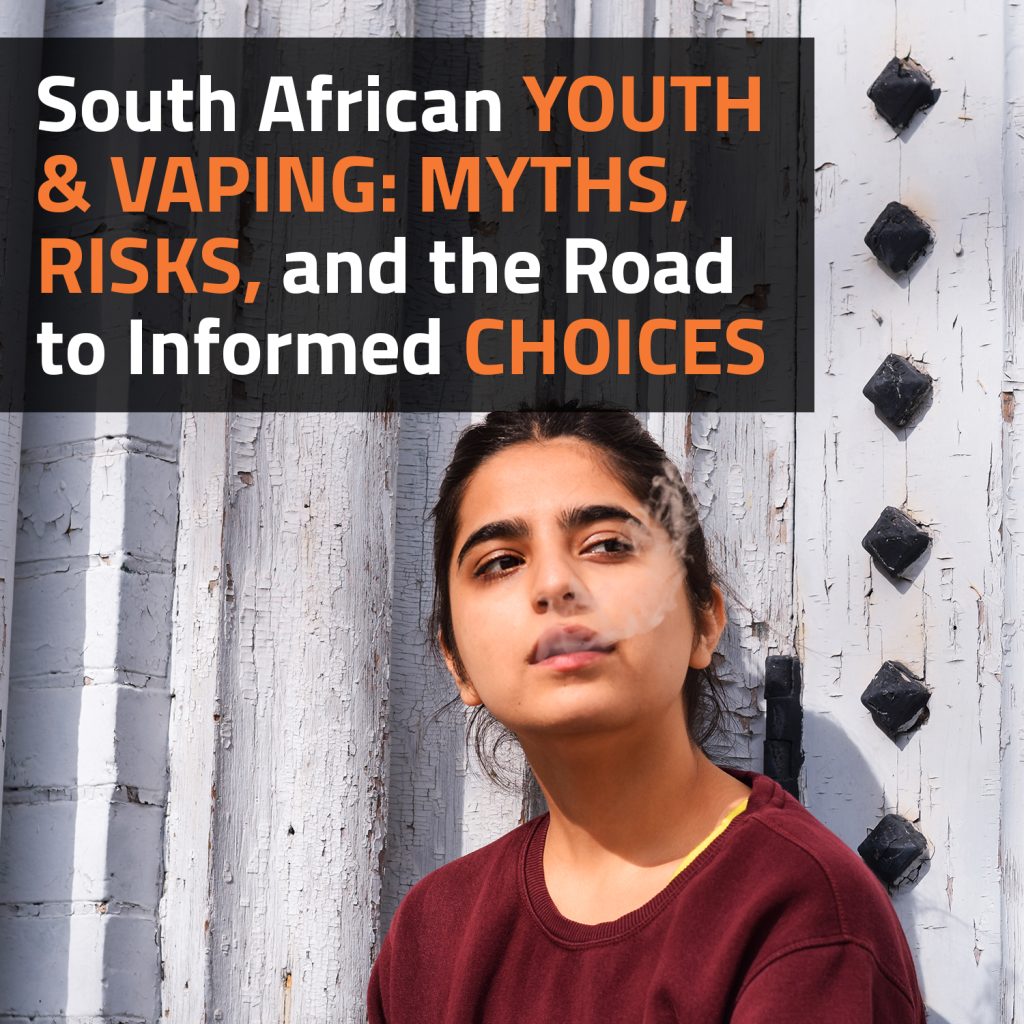In the diverse and dynamic landscape of South Africa, a new cultural phenomenon is making waves among its youth: vaping. With its misty allure and modern appeal, vaping has captured the imagination of many, but it’s a narrative that’s as complex as it is trendy.
Understanding Vaping
Imagine a small electronic device, not unlike a flash drive or even a small flashlight. This device, commonly referred to as an e-cigarette or vape pen, is your ticket to the world of vaping.
Here’s how it functions: Inside that sleek device is a chamber filled with a special liquid. Now, this isn’t just any liquid. It’s a concoction, often containing nicotine, mixed with flavours that can range from classic tobacco to the exotic dragon fruit and everything in between. When you activate the device, it heats this liquid just enough to turn it into a vapour. This vapour, which looks a lot like the steam rising from your morning cup of coffee, is what vapers inhale and exhale, leading to those well-known misty clouds.
What Are The Common Misconceptions About Vaping?
The intricate world of vaping is riddled with myths and misconceptions. Let’s dive into a few:
- “It’s just water vapour!”: This is a classic. Many people think that because it’s called “vaping”, it must mean that they’re inhaling water vapour. In reality, while the visual might resemble steam, but it is actually an aerosol containing various chemicals from the e-liquid.
- “All vapes contain nicotine”: Not always true. While many e-liquids do contain nicotine, there’s a growing market for nicotine-free options, especially for those who vape for the flavours and the experience, rather than the nicotine hit.
- “Vaping is only for smokers”: Another common belief is that vaping is exclusively for smokers looking for a “healthier” alternative. But, just take a peek into a vape lounge or a vaping community online, and you’ll find a diverse group of individuals, many of whom have never touched a traditional cigarette in their lives.
How Has Vaping Evolved Over The Years In South Africa?
The vaping scene in South Africa is quite the tale. If we rewound to a decade ago, vaping was almost a clandestine affair. Few knew about it, and those who did were often early adopters who caught onto the trend from abroad. But oh, how times have changed!
Neon-lit vaping lounges have become urban hotspots, where vapers, both novice and seasoned, gather to discuss the latest e-liquid flavours, mod customisations, and even cloud-chasing techniques.
Local events dedicated to vaping have become commonplace. Imagine music festivals, but instead of bands and DJs, you have vape trick competitions and stalls showcasing the latest in vaping tech. And the market? It’s flourishing. From high-end devices imported from tech hubs worldwide to locally brewed e-liquids that capture the essence of South Africa, there’s something for every kind of vaper.
The evolution of vaping in South Africa isn’t just about technology or trends. It’s a reflection of a global shift, one that sees people seeking new ways to define and express themselves. And in the heart of this landscape, the vibrant South African youth have found yet another canvas to paint their stories on.
Vaping Trends Among South African Youth
Recent surveys and studies are pointing towards an interesting, if not slightly concerning, trend. Vaping is on the rise among South African teens and young adults. In fact, it’s not just a mild increase; we’re talking about a significant jump in numbers.
One might wonder, “Why the surge?” Well, a big chunk of this young crowd believes that vaping stands as a knight in shining armour, saving them from the perils of traditional smoking. But as we dig deeper, we find that there’s so much more to this narrative.
What Are The Most Popular Vaping Devices And E-Liquids Among Young People?
Just like with smartphones or the latest kicks, vaping too has its trends. Walk into any vaping shop, and you’ll be met with an array of devices that could easily pass off as tech gadgets. Among these, the real show-stealers are the pod-based systems and mod devices. Why? Two reasons: They’re sleek, fitting snugly in your hand or pocket, and they’re incredibly user-friendly.
Then there are the e-liquids, the heart of the vaping experience. Remember those vibrant, bustling fruit markets in South Africa? The tang of mangoes, the sweetness of strawberries, the rich allure of vanilla? These flavours are now bottled into e-liquids. Fruit and dessert flavours, with their sweet and tantalising aromas, have captured the hearts and palates of many young vapers.
Are There Specific Demographics More Susceptible To Vaping?
Now, this is where it gets intriguing. While vaping is a nationwide trend, its epicentres can often be traced to urban hubs, places pulsating with youth, energy, and a touch of western influence.
And who’s leading this trend? Teenagers. These young souls, driven by an innate curiosity, the thrill of trying something new, and, let’s be honest, a dash of peer pressure, are at the forefront of the vaping wave. They’re experimenting, exploring, and sometimes, just trying to fit in. It’s a complex interplay of culture, influence, and personal choice. And as the clouds of vapour rise, so do the discussions, debates, and decisions surrounding this trend.
Dispelling Vaping Myths
Myth 1: Vaping is harmless and safe.
“It’s just vapour, right?” one might say. But delve a bit deeper, and you’ll find that this belief is a tad bit shaky. While vaping might lack the tar and many harmful compounds found in traditional cigarettes, the aerosol isn’t just flavoured air. It’s packed with various chemicals, and if you do not buy these from a reputable source, you are at risk of ingesting potentially dangerous chemicals.
Myth 2: Vaping doesn’t contain harmful chemicals.
“This one’s mango-flavoured, totally natural!” a salesperson might claim. And while that e-liquid might remind you of a summer mango sorbet, it’s essential to remember: what you eat and what you inhale are two very different ball games. Even though e-liquids sidestep some noxious compounds found in cigarettes, they’re not squeaky clean. Whether it’s the nicotine content, certain flavouring agents, or the base liquids like propylene glycol, they come with their own set of potential concerns when inhaled into our lungs. However, there are currently no definitive results on studies regarding the long-term implications of vaping.
Myth 3: Vaping helps quit smoking effectively.
Some indeed have found solace in vaping as a bridge to quitting smoking. However, here’s the catch: While it might work for some, it’s not a one-size-fits-all solution. The effectiveness of vaping as a universally acclaimed tool to quit smoking is still up for debate among health experts.
What Are The Consequences Of Believing These Myths?
So, with these myths floating around, often propagated by flashy adverts or half-informed peers, what’s at stake? For starters, when individuals, especially the youth, buy into these myths, they’re often making choices based on incomplete or downright incorrect information. Think about it: an uninformed vaper might choose a high nicotine e-liquid, unknowingly setting themselves up for potential addiction.
Moreover, by viewing vaping as ‘harmless’, they might overlook potential health signals like breathing issues or increased heart rate. In the long run, these myths could lead to a new generation facing health issues, all because of a few unchecked misconceptions.
In the colourful tapestry of South African culture, it’s crucial to have these conversations, challenge these myths, and ensure every puff, if taken, is an informed one.
Health Risks Associated With Vaping
Vaping, undoubtedly, has become a modern cultural phenomenon. But, like with every trend, there’s more beneath the surface.
Respiratory Issues
Inhaling vapour isn’t as smooth sailing as it’s often portrayed. Coughing spells after a vaping session are common. And that wheeze you sometimes hear? It’s not just a passing phase. For some, it’s the onset of more significant respiratory issues. There have even been alarming instances where individuals, after heavy vaping, have experienced severe respiratory distress, leaving them gasping for breath – a far cry from the carefree image of vaping.
Nicotine Addiction
Now, let’s talk about that little ingredient that packs a punch – nicotine. With every puff, they’re consuming nicotine, often without realising the implications. This sneaky chemical can latch onto you, craving more with each passing day. Over time, what started as a casual puff here and there can escalate to frequent sessions, marking the onset of nicotine addiction.
Lung Diseases
Ever heard of diacetyl? It’s a chemical used in some e-liquids, especially those with a buttery flavour. While it might make the vapour taste like popcorn, it’s been linked to a lung disease colloquially known as ‘popcorn lung’.
Cardiovascular Problems
Think of your heart as the rhythmic drummer of your body, setting the pace for life. Now, introduce it to regular doses of nicotine from vaping. The result? A drummer that’s out of sync. Nicotine can increase your heart rate, raise your blood pressure, and over time, increase the risk of heart diseases.
How Do These Risks Affect South African Youth?
With the rising tide of young vapers in South Africa, the potential health risks aren’t just personal; they’re national. Hospitals and clinics might see an uptick in respiratory and cardiovascular cases linked to vaping. Families might grapple with the emotional and financial strains of treatment and rehabilitation. And for the individual? A compromised quality of life, where climbing a flight of stairs or dancing at a festival might become a challenge.
For South Africa, a country that thrives on the vibrancy and potential of its youth, it’s crucial to understand and address these implications, ensuring a future that’s not just smoke-free, but also full of breathtaking possibilities.
Regulation And Legislation
Now, if you think vaping is a wild west with no sheriff in town, you’d be mistaken. South Africa, like many countries, has taken a keen interest in the vape game, setting up a framework to keep things in check.
First off, there’s the age game. Much like traditional cigarettes, there’s an age bar. You’ve got to be 18 or older to get your hands on vaping products. So, for all those teens eyeing that flashy vape pen, the law says, “Hold on, buddy, not yet!”
Then, there’s the big world of advertising. Remember those cigarette ads from yesteryears? Suave models, puffing away, making smoking seem glamorous? Well, with vaping, the South African regulators have been proactive. There are strict limits on how vaping can be advertised, ensuring it’s not painted as the ‘cool’ or ‘safe’ thing to do, especially in mediums frequented by the younger audience.
Lastly, it’s not just about who vapes, but also what they vape. E-liquids, devices, components – they all come under scrutiny, ensuring what’s in the market meets certain quality and safety standards.
Are These Regulations Effective In Curbing Youth Vaping?
Here’s the tricky part. While the regulations sound robust on paper, the real world, especially the digital one, presents its own set of challenges. Sure, the age restriction has kept many retailers in check, but what about online sales? A teenager with a credit card, a bit of tech-savvy, and the determination to vape can easily find loopholes.
Furthermore, the vaping industry is like that trendy club downtown – always evolving, always innovating. New products, designs, and even e-liquid formulations pop up frequently, making it a game of cat and mouse for regulators.
What Can Be Done To Strengthen Vaping Regulations In The Country?
For starters, the word on the street (and screen) has to change. Public awareness campaigns, not just highlighting the potential risks of vaping but also the regulations, can make a significant difference. Think of it as a grassroots movement where every individual, informed and aware, becomes a torchbearer of responsible vaping.
Next up, sales channels, especially the digital ones, need tighter monitoring. Age verification processes, stricter online sale checks, and perhaps even geotagging can help curb underage purchases.
Lastly, keep an eye on the horizon. By actively monitoring global and local vaping trends, South Africa can anticipate challenges and mould its regulations accordingly, ensuring they’re not just reactive, but proactive.
Educating The Youth On Vaping: A Joint Effort
Navigating the teenage years is a bit like sailing a ship through stormy seas. Challenges, temptations, peer pressures, and a quest for identity form the tempestuous waves. In such times, the role of lighthouses, in the form of schools and parents, becomes crucial. Vaping, the modern siren, beckons many a youth, making it ever so important for these guiding forces to step in.
How Can Schools And Parents Play A Part In Educating Youth About Vaping?
Incorporating vaping education into school curricula isn’t just about presenting facts and figures. It’s about sparking conversations, fostering critical thinking, and empowering students to make informed decisions. Schools, with their structured environment, can provide students with not just knowledge, but also the tools to critically evaluate the bombardment of information (and misinformation) they encounter daily.
Parents, instead of adopting a confrontational or preachy tone, foster an open dialogue. It’s not about “You shouldn’t vape” but more “Let’s discuss vaping. What do you think?”. Such conversations, rooted in trust and understanding, can often lead to more profound insights and more robust resolutions than any lecture.
What Initiatives Are In Place To Raise Awareness About Vaping Risks?
South Africa, in its vibrant and dynamic spirit, hasn’t been passive. Numerous national campaigns, often adorned with catchy slogans and impactful visuals, adorn billboards and TV screens, highlighting the potential risks of vaping. Helplines, buzzing with trained professionals, offer guidance to curious minds or those seeking help. Schools, in tandem with health organisations, often organise workshops, seminars, and interactive sessions, ensuring students get a 360-degree view of the vaping landscape.
Support And Resources For Quitting
Beyond the misty clouds of vapour lies a network of support. National helplines, buzzing day and night, offer a listening ear and expert advice. Community groups, often spearheaded by former vapers, provide a platform for sharing experiences, challenges, and success stories. Then there’s the digital realm, brimming with online forums, websites, and apps, offering guidance, tracking tools, and support at the click of a button.
Are There Local Support Groups Or Helplines For Vaping Addiction?
Absolutely! Various provinces and cities in South Africa boast dedicated helplines for nicotine and vaping addiction. These helplines aren’t just about counselling. They offer resources, connect individuals to local support groups, and sometimes, provide the simple reassurance that one isn’t alone in their journey.
In the vibrant tapestry of South African culture, where youth plays such a pivotal role, understanding, addressing, and supporting the challenges of vaping become not just individual quests, but a collective endeavour. And as the African proverb goes, “It takes a village…”
Navigating the world of vaping, especially among the South African youth, is a journey filled with myths, trends, challenges, and opportunities. As the mist of misconceptions clears, the role of education, dialogue, and community support shines through. By fostering informed choices, embracing open conversations, and offering steadfast support, South Africa can ensure that its vibrant youth strides forward with clarity, health, and purpose.






